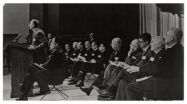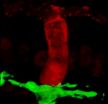(Press-News.org) Twentieth-century tobacco control programs and policies were responsible for preventing more than 795,000 lung cancer deaths in the United States from 1975 through 2000, according to an analysis funded by the National Cancer Institute (NCI), part of the National Institutes of Health.
If all cigarette smoking in this country had ceased following the release of the first Surgeon General's report on smoking and health in 1964, a total of 2.5 million people would have been spared from death due to lung cancer in the 36 years following that report, according to the analysis. The results of this study were published online March 14, 2012, in the Journal of the National Cancer Institute.
"These findings provide a compelling illustration of the devastating impact of tobacco use in our nation and the enormous benefits of reducing rates of smoking," said Robert Croyle, Ph.D., director of the Division of Cancer Control and Population Sciences at NCI. "Although great strides have been made, we cannot relax our efforts. The prevention and cessation of tobacco use continue to be vital priorities for the medical, scientific, and public health communities."
The researchers, part of the NCI-sponsored Cancer Intervention and Surveillance Modeling Network (CISNET), utilized a comparative modeling approach in which they constructed detailed cigarette smoking histories for individuals born from 1890 through 1970, and then related the histories to lung cancer mortality in mathematical models. Using these models, the researchers were able to estimate the impact of changes in smoking patterns resulting from tobacco control activities on lung cancer deaths during the period from 1975 through 2000. Since the 1964 report, tobacco control efforts in the United States have included restrictions on smoking in public places, increases in cigarette excise taxes, limits on underage access to cigarettes, and efforts to increase public awareness of the hazards of smoking.
"This is the first attempt to quantify the impact of changes in smoking behaviors on lung cancer mortality based on detailed reconstruction of cigarette smoking histories," said lead author Suresh Moolgavkar, M.D., Ph.D., of the Fred Hutchinson Cancer Research Center in Seattle. "The methods that were developed as a part of this research should prove to be invaluable to other researchers investigating the adverse health impacts of cigarette smoking."
In the study, the researchers created three scenarios. In the first, called actual tobacco control, they used data on actual smoking behaviors of men and women in the United States. The second, called no tobacco control, predicted smoking behaviors that would have existed if no tobacco control policies were put in place. In the third, called complete tobacco control, the researchers examined the possible outcome if all smoking in the United States had ceased as of 1965, the first full year after the 1964 Surgeon General's Report on Smoking and Health was released.
The difference between lung cancer deaths in the no tobacco control scenario and the numbers of actual lung cancer deaths provided an estimate of the numbers of lung cancer deaths averted as a result of tobacco control activities. This difference is graphically represented in two charts accompanying this release, based on data from Yale University, which created one of the models used in this analysis. The researchers estimated that, without tobacco control programs and policies, an additional 552,000 men and 243,000 women would have died of lung cancer in the period from 1975 through 2000.
Similarly, the difference between the no tobacco control scenario and the complete tobacco control scenario provides an estimate of the lung cancer deaths that could have been avoided if everyone who smoked quit in 1965 and no one started smoking. If tobacco control efforts had been completely successful, an additional 1.7 million lung cancer deaths would have been averted from 1975 through 2000. In total, if all smoking had ceased completely in 1965, as many as 2.5 million fewer people would have died from lung cancer (1.6 million men and 883,000 women).
"An overwhelming majority of lung cancer deaths can be prevented by eliminating cigarette smoking," said study author Eric Feuer, Ph.D., chief of NCI's Statistical Methodology and Applications Branch. "The progress that has been made by tobacco control programs and policies in reducing lung cancer deaths represents about a third of the progress that could have been made if all cigarette smoking had ceased in 1965. This finding indicates that, while great strides have been made in tobacco control – averting hundreds of thousands of lung cancer deaths in the United States – continued and enhanced efforts have the potential to avert even more deaths."
The researchers estimations only run through the year 2000 because, for more recent years, sufficiently detailed data were unavailable when the project began. However, it can be inferred that additional lung cancer deaths have been averted since the year 2000, because according to previous research, smoking rates among U.S. adults have continued to fall, dropping from 23.2 percent in 2000 to 20.6 percent in 2008, and leveling off in recent years. Previous research indicates that much of the decrease in smoking rates can be attributed to tobacco control policies. In addition, although beyond the scope of the journal article, rates of other smoking related cancers, and smoking-related diseases, such as cardiovascular and respiratory diseases, have declined due to tobacco control programs and policies.
In 2011, researchers conducting the National Lung Screening Trial (NLST) found that screening heavy smokers with low-dose spiral CT reduced lung cancer mortality by 20 percent, compared to standard chest X-ray (for more information, see the press release on this study). Even with the potential mortality benefits associated with screening, continued implementation of evidence-based tobacco control policies, programs, and services remains a critical approach to reducing the burden of lung cancer, according to the authors.
CISNET is a consortium of NCI-sponsored investigators who use statistical modeling to improve our understanding of cancer control interventions in prevention, screening, and treatment. This modeling approach, which has been validated in several previous studies, can be used to guide public health research and priorities. The network is working on a project to study the efficacy of lung cancer screening for smokers in different age and exposure level groups, based on the results of benefit for spiral CT screening found in the NLST for heavy smokers.
The results discussed in the paper are based on six different models, developed by members of the CISNET network. The centers that created these models include Erasmus Medical Center, The Netherlands; Fred Hutchinson Cancer Research Center, Seattle; Pacific Institute for Research and Evaluation, Calverton, Md.; Rice University-M.D. Anderson Cancer Center, Houston; Massachusetts General Hospital-Harvard Medical School, Boston; and Yale University, New Haven, Conn. More details about the construction of models will be published in a forthcoming special issue of Risk Analysis – An International Journal.
INFORMATION:
The NCI's Division of Cancer Control and Population Sciences funded the research under grant numbers CA097415, CA097432, CA097450, CA097431, CA097416, CA097337, CA152956, CA126147, and CA133141.
For more information about CISNET, please visit http://cisnet.cancer.gov/index.html
For more information about NCI's Division of Cancer Control and Population Sciences, please visit http://cancercontrol.cancer.gov.
NCI leads the National Cancer Program and the NIH effort to dramatically reduce the burden of cancer and improve the lives of cancer patients and their families, through research into prevention and cancer biology, the development of new interventions, and the training and mentoring of new researchers. For more information about cancer, please visit the NCI Web site at http://www.cancer.gov or call NCI's Cancer Information Service at 1-800-4-CANCER (1-800-422-6237).
About the National Institutes of Health (NIH): NIH, the nation's medical research agency, includes 27 Institutes and Centers and is a component of the U.S. Department of Health and Human Services. NIH is the primary federal agency conducting and supporting basic, clinical, and translational medical research, and is investigating the causes, treatments, and cures for both common and rare diseases. For more information about NIH and its programs, visit http://www.nih.gov.
Reference: Moolgavkar SH, Holford TR, Levy DT, Kong CY, Foy M, Clarke L, Jeon J, Hazelton W, Meza R, Schultz F, McCarthy W, Boer R, Gorlova O, Gazelle GS, Kimmel M, McMahon PM, de Koning HJ, Feuer EJ. Impact of the Reduction in Tobacco Smoking on Lung Cancer Mortality in the U.S. over the Period 1975-2000. JNCI. Mar. 14, 2012.
Nearly 800,000 deaths prevented due to declines in smoking
NIH study examines the impact of tobacco control policies and programs, and the potential for further reduction in lung cancer deaths
2012-03-15
ELSE PRESS RELEASES FROM THIS DATE:
Study finds genes improving survival with higher chemo doses in leukemia
2012-03-15
CLEVELAND -- New research published in the March 15 issue of the New England Journal of Medicine (embargoed 5 pm ET March 14) identifies gene mutations associated with improved overall survival with higher doses of chemotherapy for patients with acute myeloid leukemia (AML).
According to one of the authors, Hillard M. Lazarus, MD, Director of Novel Cell Therapy at Seidman Cancer Center at University Hospitals Case Medical Center and Professor of Medicine at Case Western Reserve University School of Medicine, the findings explain why some AML patients are more likely ...
New study lowers estimate of ancient sea-level rise
2012-03-15
The seas are creeping higher as the planet warms. But how high will they go? Projections for the year 2100 range from inches to several feet, or more. The sub-tropical islands of Bermuda and the Bahamas contain important sites where researchers have gone looking for answers; by pinpointing where shorelines stood on cliffs and reefs there during an extremely warm period 400,000 years ago, they hope to narrow the range of global sea-level projections for the future.
After correcting for what they say were the sinking of the islands at that time, a new study in the journal ...
Study: US tobacco-control efforts prevented nearly 800,000 cancer deaths between 1975 and 2000
2012-03-15
SEATTLE – Declines in cigarette smoking among Americans since the mid-1950s – particularly since tobacco-control policies and interventions were implemented after the U.S. Surgeon General's Report on Smoking and Health was released in 1964 – prevented nearly 800,000 lung cancer deaths between 1975 and 2000, according to a study led by researchers at Fred Hutchinson Cancer Research Center.
Results of the National Cancer Institute-funded study, conducted by a consortium of six research groups in the U.S. and the Netherlands, are published online in the Journal of the National ...
Study Shows Chemotherapy Combination Effective for Mesothelioma Patients
2012-03-15
Individuals suffering from Mesothelioma know all too well the aggressive nature of the disease. Fortunately, a new clinical trial shows positive results for some patients taking a particular type of chemotherapy combination.
What is Mesothelioma?
Mesothelioma is a rare type of cancer that afflicts the meothelium or thin membrane that covers a person's lungs, heart and other vital organs. The cancer is most commonly caused by the inhalation of microscopic asbestos fibers.
Asbestos fibers were first used by U.S. manufacturers and builders in the late 19th century ...
Mystery human fossils put spotlight on China
2012-03-15
Fossils from two caves in south-west China have revealed a previously unknown Stone Age people and give a rare glimpse of a recent stage of human evolution with startling implications for the early peopling of Asia.
The fossils are of a people with a highly unusual mix of archaic and modern anatomical features and are the youngest of their kind ever found in mainland East Asia.
Dated to just 14,500 to 11,500 years old, these people would have shared the landscape with modern-looking people at a time when China's earliest farming cultures were beginning, says an international ...
Reducing drug overdose for ex-prisoners -- the view from outside the prison gates
2012-03-15
Prison inmates frequently have a strong history of drug use and misuse, especially during the time prior to incarceration, and drugs often are the driving force behind the offense itself. New research, published in BioMed Central's newly launched open access journal Addiction Science & Clinical Practice, shows that ex-offenders struggle to remain drug free after release from prison and identifies factors that can help them succeed. Interviews with former inmates show that they themselves recognize that returning to former living environments (former friends and an easy ...
Social networking shortcut to finding medical experts
2012-03-15
It can be difficult for someone outside of a specialist field to identify subject experts and the ever increasing amount of available data can be bewildering. New research, published in BioMed Central's open access journal, Journal of Biomedical Semantics, describes a method of social network analysis, similar to finding friends on Facebook, able to sift through scientific literature and news articles to identify opinion leaders and media experts.
Pharmaceutical companies and public health programs rely on opinion leaders to clarify and condense research into a format ...
'Personalized immune' mouse offers new tool for studying autoimmune diseases
2012-03-15
New York, NY (March 14, 2012) — Columbia University Medical Center (CUMC) scientists have developed a way to recreate an individual's immune system in a mouse. The "personalized immune mouse" offers researchers an unprecedented tool for individualized analysis of abnormalities that contribute to type 1 diabetes and other autoimmune diseases, starting at the onset of disease. The findings were published today in the online edition of Science Translational Medicine.
The mouse model could also have clinical applications, such as predicting how a particular patient might ...
Study finds expensive procedure no more effective than medical therapy to prevent strokes
2012-03-15
CLEVELAND -- A catheter procedure that closes a hole in patients' hearts was no more effective than medical therapy in preventing recurrent strokes, according to a new study published in the March 15 issue of the New England Journal of Medicine.
In the CLOSURE I trial, clinical researchers compared a catheter procedure plus medical therapy with medications alone to prevent new strokes or transient ischemic attacks (TIAs) in patients between 18 and 60 years old with an unexplained ("cryptogenic") stroke or TIA and a patent foremen ovale (PFO) – a hole between the heart's ...
Researchers identify unexpected player in intestinal immunity
2012-03-15
VIDEO:
Using two-photon imaging, the researchers were able to see dendritic cells, shown in green, in the intestine of a living mouse.
Click here for more information.
With every meal, immune cells in the intestine stand like sentries at a citadel, turning away harmful bacteria but allowing vitamins and nutrients to pass.
Now, researchers at Washington University School of Medicine in St. Louis have identified the cells that chaperone food antigens, or proteins, in the ...
LAST 30 PRESS RELEASES:
Sweeping study shows similar genetic factors underlie multiple psychiatric disorders
How extreme weather events affect agricultural trade between US states
Smallholder farms maintain strong pollinator diversity – even when far from forests
Price of a bot army revealed across hundreds of online platforms worldwide – from TikTok to Amazon
Warblers borrow color-related genes from evolutionary neighbors, study finds
Heat signaling from plants is an ancient pollinator signal
New index reveals the economics underlying the online manipulation economy
High-resolution satellite observations reveal facility-level methane emissions worldwide
Researchers discover how Ebola and Marburg disrupt the gastrointestinal tract
Feeling the heat
Eastward earthquake rupture progression along the Main Marmara Fault towards Istanbul
Scientists uncover how Earth’s mantle locked away vast water in early magma ocean
Scientists uncover key driver of treatment-resistant cancer
Rare image of Tatooine-like planet is closest to its twin stars yet
Music: Popular song lyrics have become more negative since 1973
Marine ecology: Killer whales tail dolphins to hunt salmon
ADHD prescriptions on the rise, study finds
How to build a genome
Sharp rise in ADHD stimulant prescriptions in Ontario, research finds
Trends and prevalence of the metabolic syndrome among US adults
Population-level trends in ADHD medication prescribing
Missing piece of myelin disturbs the brain’s rhythm
Insilico Medicine and Taigen achieves license agreement to develop and commercialize AI-driven PHD inhibitor for anemia of Chronic Kidney Disease (CKD)
Exploring dominant endophytic Pleosporales in grasses: New taxonomic insights in the suborder Massarineae
Comparative transcriptomic analysis of human maxillary and mandibular tooth germs reveals discrepancies in gene expression patterns
Scientists detect atmosphere on molten rocky exoplanet - study
Chip-scale magnetometer uses light for high-precision magnetic sensing
Illinois Tech biomedical engineering professor Philip R. Troyk elected as Fellow of the National Academy of Inventors
The National Academy of Inventors welcomes 2025 Class of Fellows
Multi-scale modelling framework predicts mechanical responses of Fe–Cr–Al alloys across composition and processing conditions
[Press-News.org] Nearly 800,000 deaths prevented due to declines in smokingNIH study examines the impact of tobacco control policies and programs, and the potential for further reduction in lung cancer deaths



